Final blend shapes for shot_19
I've been creating some blend shapes for the iceman, to allow for a subtle change in his expression, for a final close up shot.
Below: Mudbox screen shots showing the view panel, the sculpt layers on the right. The red indicates the mask tool, for when creating a blinking eye.
For some weird reason that we can't discover, the blend shapes, when exported directly to Maya, created irregular deformation of the legs; so the method below is based on the old style method of exporting blend shapes into Maya
Process:
MAYA
Select geometry
Select 'Send to Maya' (drop down menu under 'File'
Go to: MUDBOX
Create group in Sculpt Layers
Create new layer
Sculpt desired expression e.g smile. Once happy with the sculpt, save.
Duplicate layer (at this point the geometry will show double strength and will look very distorted. Simply turn off the visibility of the new duplicated layer.
Select the original layer and rename for either left of right. E.g 'L_smile'
Select the mask tool and also select the mask icon (at the top of the layers menu).
This will create a red mask brush.
Apply the red mask to the geometry that is to remain unaffected by the blend shape. E.g for the layer 'L_smile' apply a mask to the right hand side of the face. Once done
Turn off visibility of the layer.
Select the duplicated layer and re-name. E.g 'R_smile'. Turn on visibility. Apply mask
Repeat the above for all blend shape expressions.
Select the geometry (in object tab, adjacent to the layers menu)
Enable one blend shape layer at time.
e.g Left Smile
Create a folder in the Maya project, to save the blend shapes.
Export selection as an .obj file.
Go to: MAYA
File > import obj files
(They appear as geometry in the Outliner)
Re-name clearly
Once all obj files are imported, select them in order of blend shape (however preferred), making sure that the main geometry is the last to be selected)
Hide obj files in Outliner
Open Animation Deformer Tab
Select Blend Shape option box
Rename blend shape node
Open blend shapes, by selecting 'windows' > 'animation editors' > 'blend shapes'
Blend shapes should appear and be working!













































